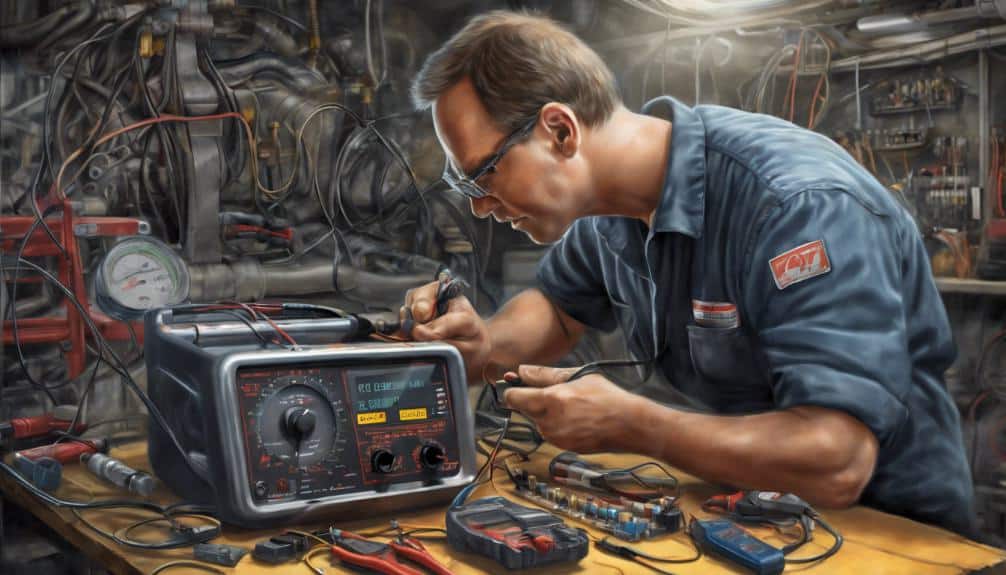If you’re dealing with the P0328 Code due to high voltage in Knock Sensor 1 Circuit, make sure sensor calibration accuracy. Any voltage spikes can cause false readings.
First, inspect sensor and wiring for issues triggering the high voltage. Test connections for open circuits affecting voltage levels. Whats more, check PCM circuitry for faults that may elevate voltage.
Promptly addressing this issue is essential for engine health and efficiency. After resolving P0328, monitor engine performance for abnormalities. Address any recurring issues to avoid engine damage.
Understanding these steps will help you tackle the high voltage in Knock Sensor 1 Circuit effectively.
Key Points
- Verify knock sensor 1 for high voltage output triggering P0328.
- Inspect sensor for damage affecting voltage readings.
- Test sensor functionality and check for open circuits.
- Evaluate PCM circuit for faults causing elevated voltage.
- Address promptly to prevent engine damage and poor performance.
Understanding the P0328 Diagnostic Trouble Code

If you encounter the P0328 Diagnostic Trouble Code, you may notice that it indicates high voltage in the Knock Sensor 1 circuit.
This code is triggered when there are voltage fluctuations beyond the specific threshold in the Knock Sensor 1 (bank 1) circuit.
Understanding how sensor calibration plays an important role in detecting engine knocking issues is essential when dealing with the P0328 DTC.
Sensor calibration guarantees that the Knock Sensor 1 accurately interprets engine sounds and vibrations, helping to identify potential problems like knocking or pinging.
Voltage fluctuations in the circuit can disrupt this calibration, leading to false readings and triggering the P0328 code.
It’s essential to inspect the sensor and its related circuitry to determine if the issue lies in the sensor itself or the wiring connections.
Potential Causes of High Voltage in Knock Sensor 1 Circuit
High voltage in the Knock Sensor 1 circuit may stem from various factors such as sensor failure or open lines. Voltage fluctuations can also contribute to this issue.
When the sensor malfunctions, it can send incorrect signals to the PCM, resulting in elevated voltage levels in the circuit.
Furthermore, if there’s a fault in the PCM’s internal circuitry, it can cause high voltage readings in the Knock Sensor 1 circuit.
The malfunction threshold for DTC P0328 is directly linked to the voltage output of Knock Sensor 1. To diagnose and resolve this issue, it’s important to monitor the voltage levels in the circuit accurately.
Understanding these potential causes of high voltage in the Knock Sensor 1 circuit is essential for effectively identifying and rectifying the problem.
By pinpointing the source of the high voltage, you can take the necessary steps to address the issue and clear the P0328 trouble code.
Steps to Diagnose and Resolve P0328 Code

To effectively address the P0328 trouble code, begin by conducting a thorough diagnostic assessment of the Knock Sensor 1 circuit.
Start by checking for voltage fluctuations in the circuit, as high voltage triggers the P0328 code. Inspect the sensor for any signs of damage or wear that could lead to erratic voltage readings.
Proceed with sensor testing to make sure it’s functioning correctly and accurately detecting engine knocking. Test the sensor’s connections and wiring for any open circuits that may cause voltage spikes.
If the sensor tests fine, examine the PCM circuit for any faults that could be causing the high voltage issue.
Clearing the P0328 DTC requires resolving the root cause of the high voltage in the Knock Sensor 1 circuit.
By methodically diagnosing and addressing voltage fluctuations and conducting thorough sensor testing, you can effectively resolve the P0328 trouble code.
How Can A Circuit Open Impact Voltage in the Knock Sensor 1 Circuit?
When a circuit open occurs in the sensor reference voltage circuit for Knock Sensor 1, it disrupts the flow of voltage to the sensor. This can lead to inaccurate readings and potentially cause the sensor to malfunction, impacting the overall performance and efficiency of the vehicle’s engine.
Importance of Addressing Knock Sensor Issues Promptly
Addressing knock sensor issues promptly is vital for maintaining the health and efficiency of your engine and preventing potential complications. Ignoring these issues can lead to engine damage and decreased performance.
High voltage in the knock sensor 1 circuit, as indicated by the P0328 code, requires immediate attention to prevent further problems.
Failure to address this issue can result in poor fuel economy and potential drivability issues.
Timely diagnosis and repair of knock sensor problems play an important role in preventive maintenance, ensuring smooth engine performance.
By promptly addressing high voltage in the knock sensor circuit, you can maintain the overall health of your engine and prevent potential complications that may arise.
Ensuring Smooth Engine Operation After Resolving P0328

After resolving the P0328 code, focus on guaranteeing the smooth operation of your engine by monitoring for any unusual noises or vibrations.
Conduct a test drive to assess the vehicle’s performance and responsiveness post-repair.
During the drive, pay close attention to how the engine behaves, accelerates, and handles different road conditions.
This monitoring process will help you gauge if any issues persist or if the repair successfully addressed the high voltage in Knock Sensor 1 Circuit.
On top of that, check for any recurrence of the P0328 code or related issues to confirm the effectiveness of the repair.
If you notice the code reappearing or experience similar symptoms, it may indicate that further investigation or maintenance is required.
Consider performing regular maintenance checks on the knock sensors to prevent future issues and ensure the continued smooth operation of your engine.
Consulting with a professional mechanic is advisable if any abnormal engine behavior is detected after resolving the P0328 code, as they can provide expert guidance on the next steps to take.
By monitoring performance and conducting maintenance diligently, you can keep your engine running smoothly and efficiently.
As an Amazon Associate we earn from qualifying purchases.










